
Overview
This article examines how heat map web insights can significantly enhance direct-to-consumer (DTC) brand performance by optimizing website interactions to elevate conversion rates. By showcasing successful implementations, such as a clothing brand that achieved a remarkable 35% increase in conversions through targeted adjustments based on consumer behavior data, it underscores the effectiveness of heat maps in comprehending user engagement and driving profitability. Such insights are not merely anecdotal; they represent a strategic approach that can be replicated across various DTC brands, prompting industry professionals to leverage this powerful tool for sustained growth.
Introduction
The digital marketplace is evolving at an unprecedented pace, and direct-to-consumer (DTC) brands are continually challenged to comprehend and adapt to shifting consumer behaviors. Heat map web analysis stands out as a formidable tool that not only visualizes user interactions but also uncovers critical insights capable of significantly enhancing brand performance. As companies endeavor to optimize their websites for improved engagement and profitability, a pivotal question emerges: how can the strategic use of heat map data yield substantial improvements in conversion rates and overall user experience? This article explores ten compelling ways in which heat map insights can revolutionize DTC strategies, fostering sustainable growth in an increasingly competitive landscape.
Parah Group: Enhance Conversion Rates with Heat Map Analysis
The heat map web analysis serves as an indispensable tool for DTC companies, enabling them to visualize website interactions with precision. By pinpointing where users click, scroll, and pause, businesses gain actionable insights that significantly boost conversion rates. In 2025, the utilization of thermal maps is more crucial than ever, providing a transparent view of consumer behavior and empowering companies to optimize their websites for maximum engagement and profitability.
Parah Group integrates temperature map analysis into its comprehensive Conversion Rate Optimization (CRO) strategy, ensuring that every facet of a website aligns with visitor expectations. This approach has proven effective, exemplified by a $30M clothing line that partnered with Parah Group, achieving a remarkable 35% increase in conversion rates after implementing targeted changes based on consumer behavior insights, including thermal map data. Similarly, Grab Green, a $15M cleaning product company, elevated its average order value by 80% through strategic enhancements informed by visual data analysis, such as optimizing product placement and adjusting pricing strategies based on customer engagement.
Experts in the field underscore the importance of temperature map analysis for DTC brands. Tim Ash, a leading authority in CRO, emphasizes its role as a vital component for understanding consumer behavior and refining web design. Moreover, a study indicates that companies employing thermal visuals enjoy an average return on investment of 223%, underscoring their effectiveness in driving conversions.
By harnessing the power of the heat map web visualizations, DTC companies can not only enhance customer experience but also substantially elevate their conversion rates. This data-driven approach facilitates continuous improvement, ensuring that businesses remain competitive in an ever-evolving digital landscape.
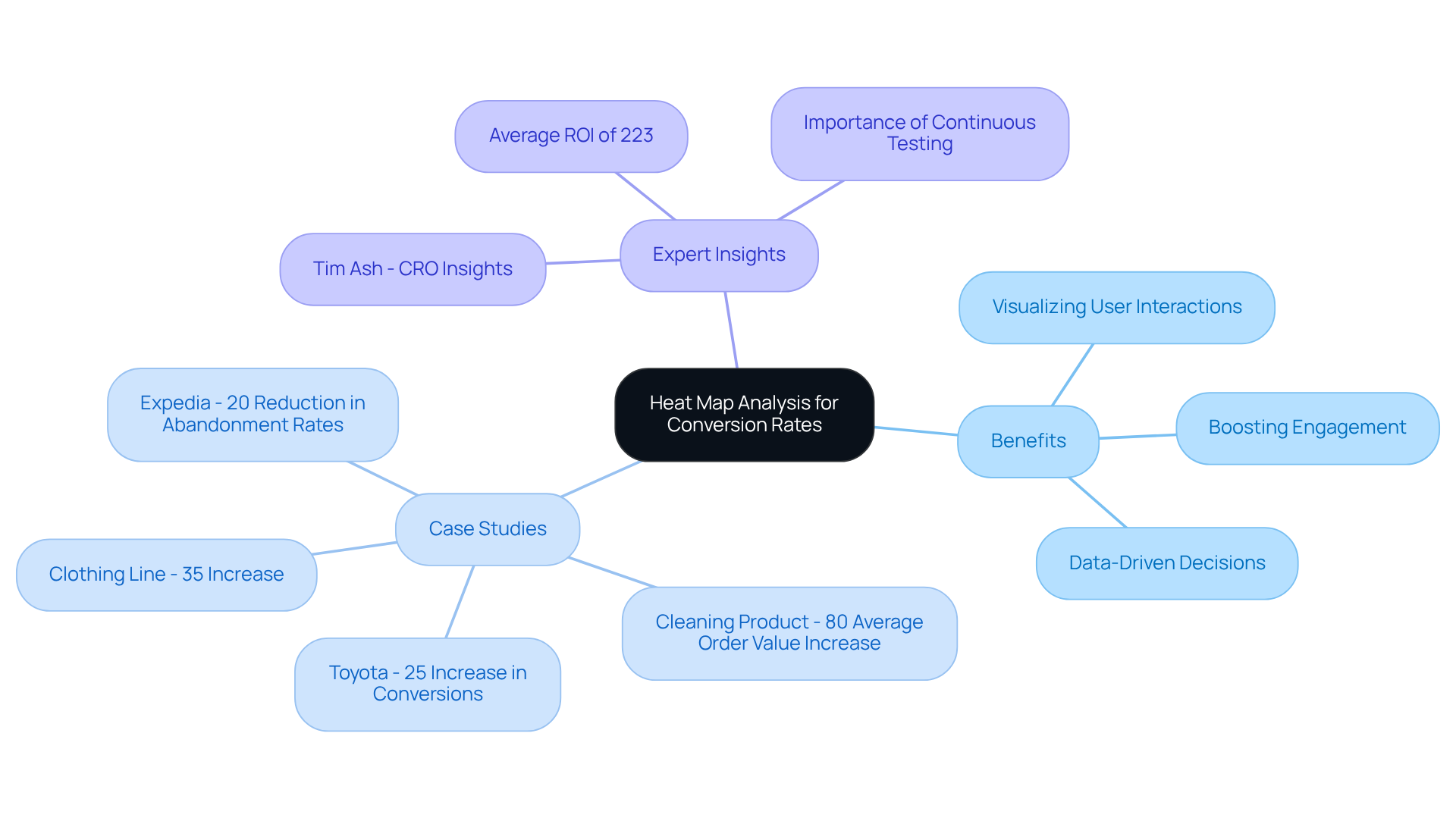
Visualize User Behavior: Understanding Customer Interactions with Heat Maps
Heat map web tools serve as powerful resources for illustrating visitor behavior, allowing companies to pinpoint which sections of their website garner the most attention. This visual representation of customer interactions reveals preferences and behaviors, allowing DTC companies to optimize their content and layout effectively. Research indicates that only 25% of individuals scroll halfway down a page, underscoring the importance of positioning essential information higher up to enhance visibility. By leveraging map insights, companies can create a more engaging and user-friendly experience that not only attracts visitors but also drives conversions.
Moreover, thermal charts foster collaboration among team members by providing clear visual evidence of participant interactions, sparking discussions that lead to design improvements. As companies adapt to evolving consumer expectations and technologies in 2025, the use of thermal visuals can significantly enhance their understanding of client behavior, ultimately resulting in improved engagement and increased sales.
In practical applications, companies have effectively utilized scroll diagrams to identify crucial information that was previously overlooked, leading to better interaction with key product details. By adjusting content positioning based on the heat map web data, companies can effectively guide clients toward purchasing decisions, ensuring a more seamless experience and higher conversion rates.

Optimize Layout: Identify High-Traffic Areas with Heat Maps
By utilizing a heat map web, companies can determine which areas of their website attract the most visitors. This critical insight is essential for optimizing layout, ensuring that key elements—such as calls to action and product displays—are strategically positioned in high-visibility areas. Effective layout optimization can significantly enhance audience engagement and elevate conversion rates.
For instance, Muc-Off experienced a remarkable 106% increase in purchases after redesigning their homepage based on insights from a heat map web analysis, underscoring the profound impact of data-driven design changes.
Furthermore, consistent examination of the heat map web visuals is paramount for ongoing advancement, empowering brands to adapt to evolving consumer behaviors. It is also imperative to ensure that data is anonymized and adheres to regulations such as GDPR, addressing potential privacy concerns while effectively leveraging heat map insights.
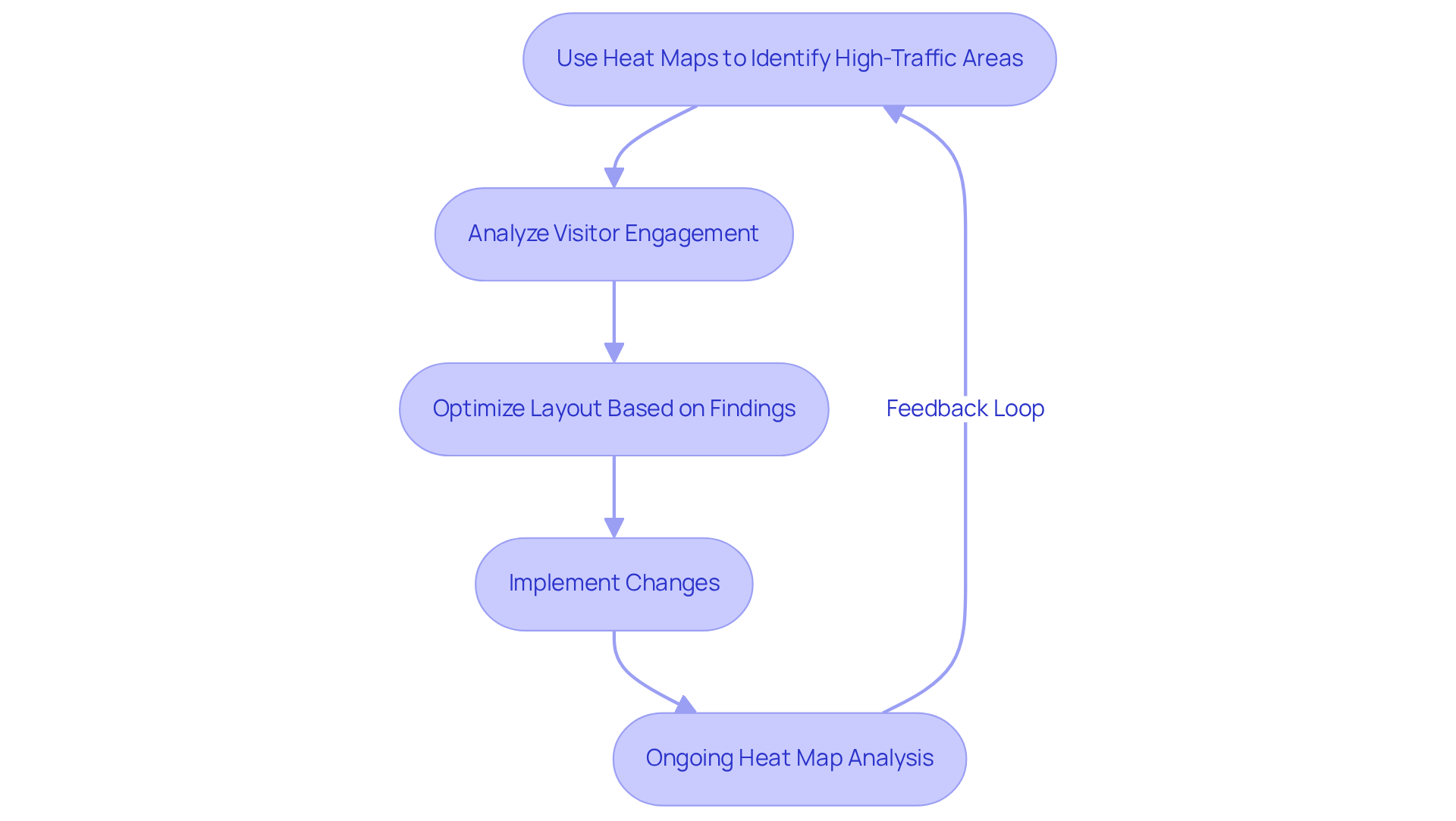
Improve User Experience: Pinpoint Confusion Areas with Heat Maps
The heat map web serves as an invaluable tool for pinpointing areas where individuals may experience confusion, particularly in complex navigation structures or ambiguous messaging. By analyzing these insights, DTC companies can identify specific points of confusion and implement crucial changes to enhance the overall customer experience.
Streamlining navigation and clarifying messaging not only alleviates frustration but also significantly boosts customer satisfaction and drives conversions. As industry specialists emphasize, understanding consumer interactions through a heat map web empowers companies to make informed design choices that resonate with their audience. This ultimately leads to improved engagement and performance.
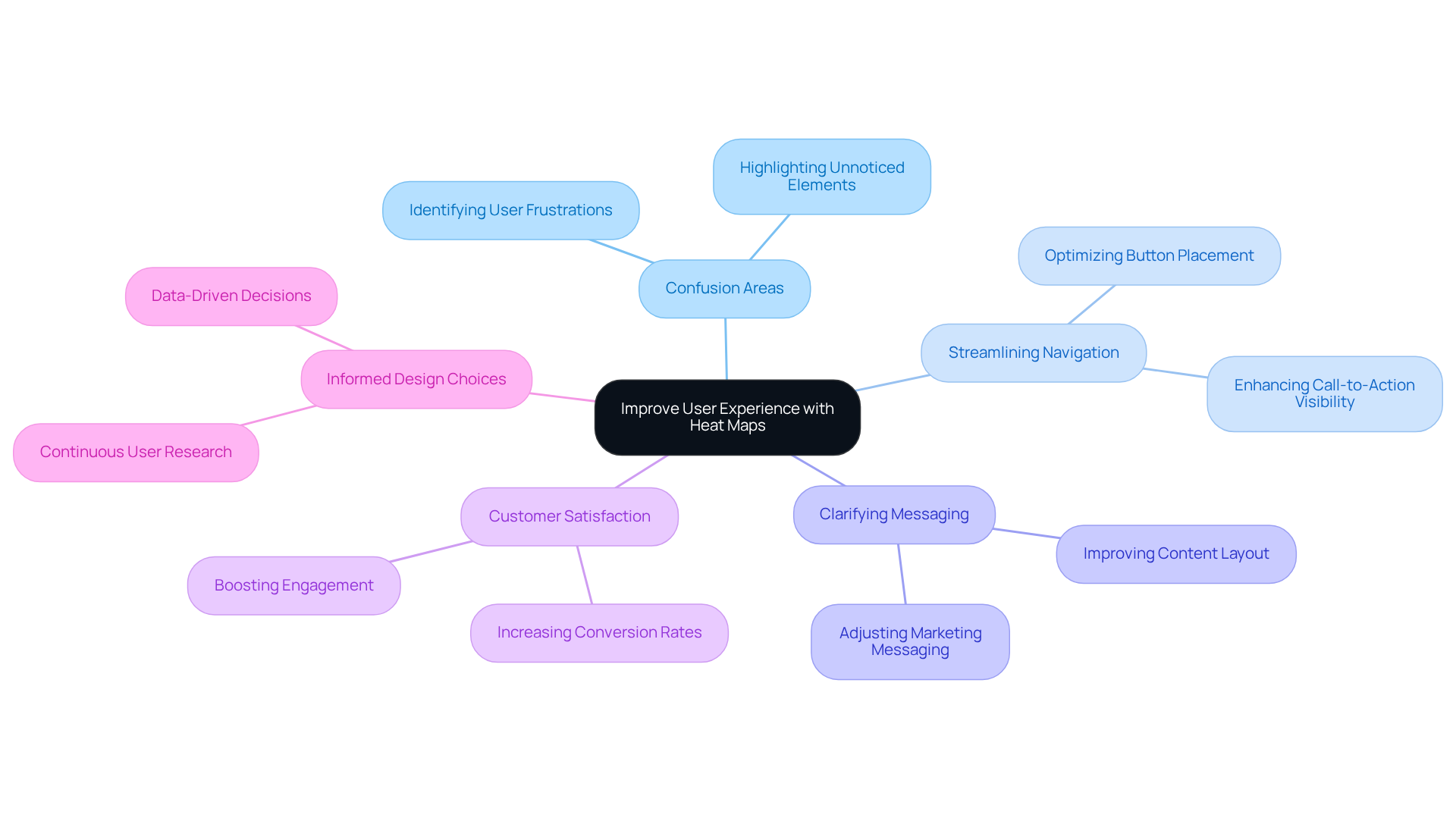
Facilitate A/B Testing: Leverage Heat Maps for Data-Driven Decisions
The heat map web serves as a critical asset in enhancing A/B testing by delivering visual insights into user interactions across various webpage versions. By meticulously analyzing temperature map data alongside A/B test outcomes, direct-to-consumer (DTC) brands can make informed decisions regarding which design or content variations yield optimal performance. This data-driven approach not only aligns modifications with genuine user behavior but also cultivates more effective optimization strategies—a principle that Parah Group staunchly advocates in its Conversion Rate Optimization (CRO) methodology.
Upon partnering with Parah Group, our onboarding process ensures the customization of our strategy and communication to meet your specific needs, facilitating a seamless integration of temperature maps into your A/B testing initiatives. Notably, 80% of companies employing mapping tools report an increase in conversions, averaging a 15% rise. For instance, brands like ASOS have successfully elevated their checkout completion rates from 60% to 84% by leveraging thermal map insights to identify and address friction points within their processes.
By utilizing a heat map web alongside Parah Group's expert CRO strategies, DTC companies can ensure that their A/B testing efforts are based on actual participant data. This ultimately leads to improved outcomes and enhances overall performance.
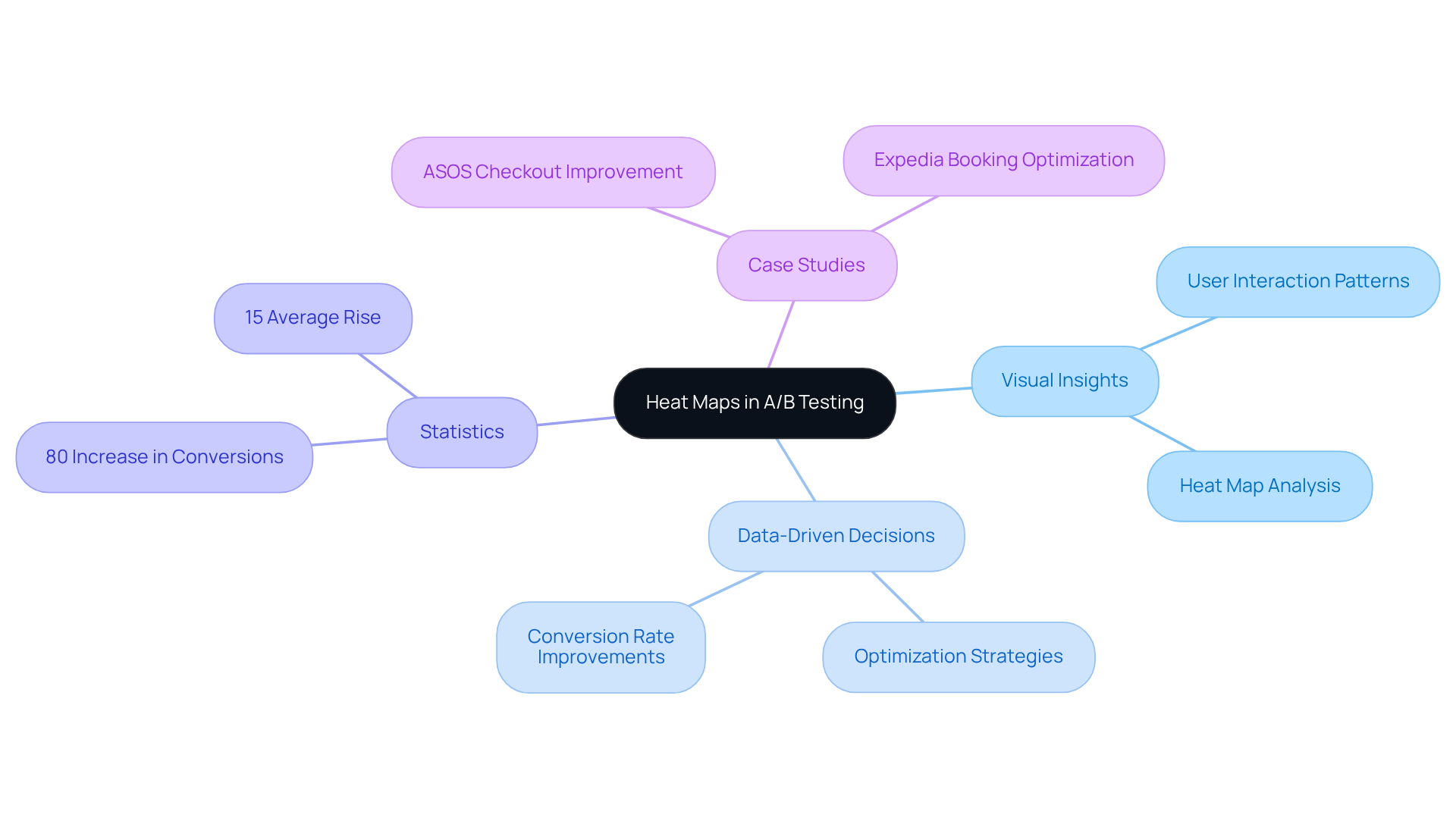
Increase Conversion Rates: Discover Attention-Grabbing Elements with Heat Maps
Heat map web tools serve as crucial instruments for companies aiming to pinpoint which components of their websites—such as images, buttons, or promotional banners—capture the most attention from visitors. By analyzing this data, DTC companies can strategically enhance their content and layout, focusing on these high-impact areas to elevate engagement.
For instance, Parah Group's collaboration with a $30M clothing brand led to a remarkable 35% increase in conversion rates after implementing targeted enhancements derived from behavioral insights. This focused approach not only enhances the overall user experience but also significantly boosts conversion rates.
Utilizing a heat map web can enhance the effectiveness of key sections, including:
- Home pages
- Landing pages
- Popular blog entries
As companies refine their strategies based on insights from the heat map web, they can expect substantial improvements in performance metrics, exemplified by a 10% increase in revenue per visitor achieved by another client. Ultimately, these optimizations drive greater profitability. Continuous testing and learning from results are vital to ensure that these enhancements remain effective over time.
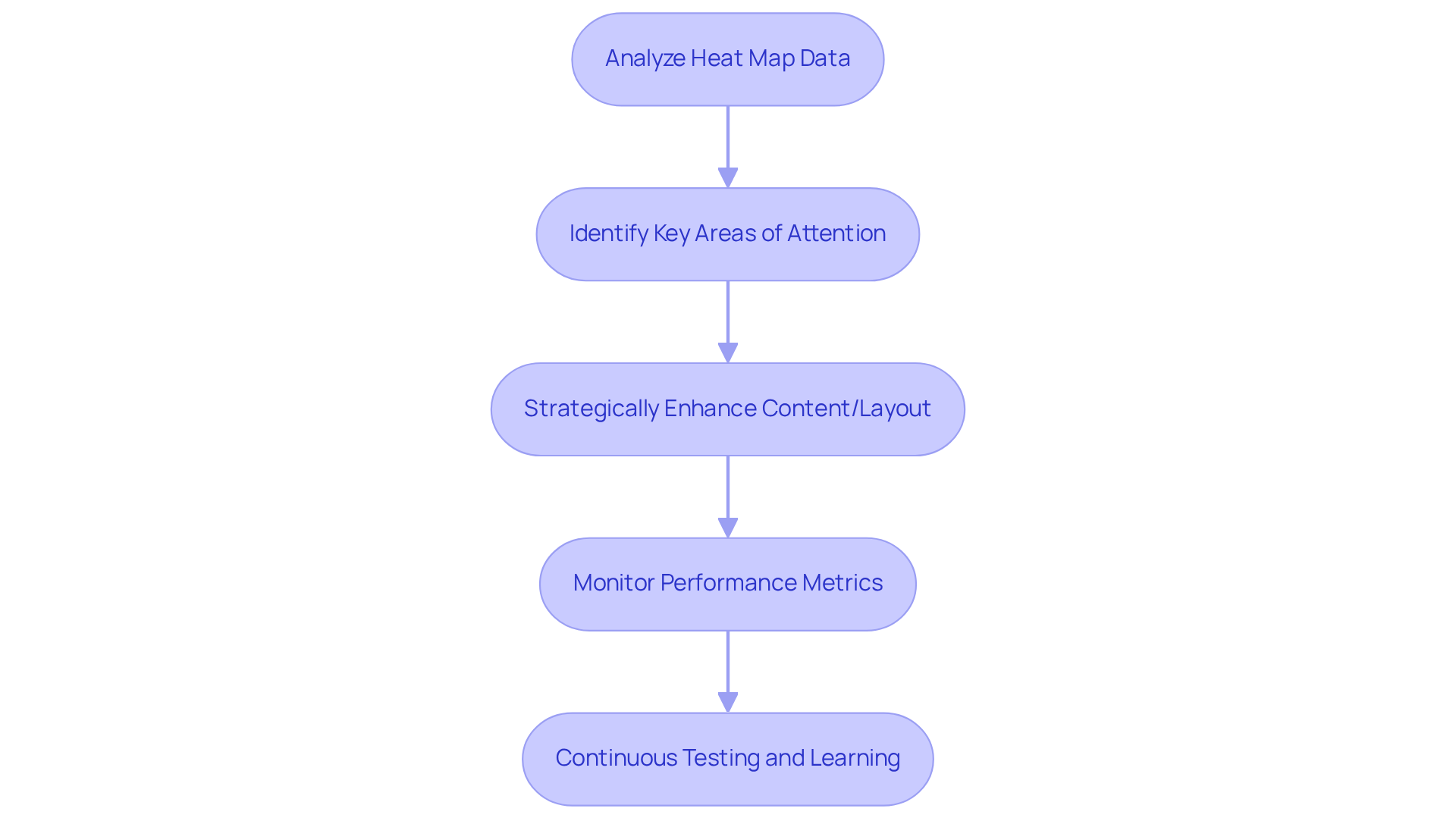
Integrate Analytics: Combine Heat Maps with Other Tools for Comprehensive Insights
Incorporating the heat map web with analytical tools such as Google Analytics and session recordings offers a powerful perspective on user behavior. This integration enables companies to correlate critical metrics like bounce rates and conversion rates with thermal map data, creating a comprehensive heat map web that leads to profound insights. Such synergy fosters effective optimization strategies that maximize profitability.
By analyzing heat map web data alongside these metrics, businesses can identify patterns and correlations that inform decision-making, ultimately enhancing user experience and driving conversions. Continuous monitoring of the heat map web insights is vital for recognizing emerging trends, allowing brands to adapt swiftly to shifts in consumer behavior.
Furthermore, leveraging A/B testing to validate modifications based on thermal map data ensures that changes yield positive results, significantly improving user interactions. This comprehensive approach not only enhances the effectiveness of graphical representations but also aligns all aspects of engagement with strategic business objectives, paving the way for sustained growth and improved performance.
Additionally, filtering out irrelevant traffic is essential to ensure that heat map web data accurately reflects genuine audience behavior, thereby enhancing the overall effectiveness of insights derived from the heat map web.

Track Engagement Over Time: Use Heat Maps to Adapt Strategies
Monitoring heat map web data over time is crucial for companies aiming to identify shifts in user engagement and behavior. By examining these evolving interactions, DTC companies can refine their strategies to align with the changing preferences and needs of customers. This continuous analysis is essential for maintaining relevance and fostering sustained growth in an increasingly competitive landscape.
For example, Parah Group has successfully transformed DTC product profitability through innovative CRO strategies, as evidenced by various case studies where companies achieved significant increases in conversion rates and average order values.
With global retail e-commerce sales estimated at $5.8 trillion and projected to grow by 39%, adapting to these trends through data-driven insights becomes imperative for maximizing conversion rates and enhancing overall performance. High drop-off rates among new users can signal friction points that require attention, underscoring the importance of ongoing analysis.
Moreover, defining a clear goal before initiating the heat map web analysis is vital for effective outcomes, as it directs the focus of the analysis. The heat map web can provide valuable insights by anticipating future engagement trends, further aiding DTC companies in their strategic adaptations.
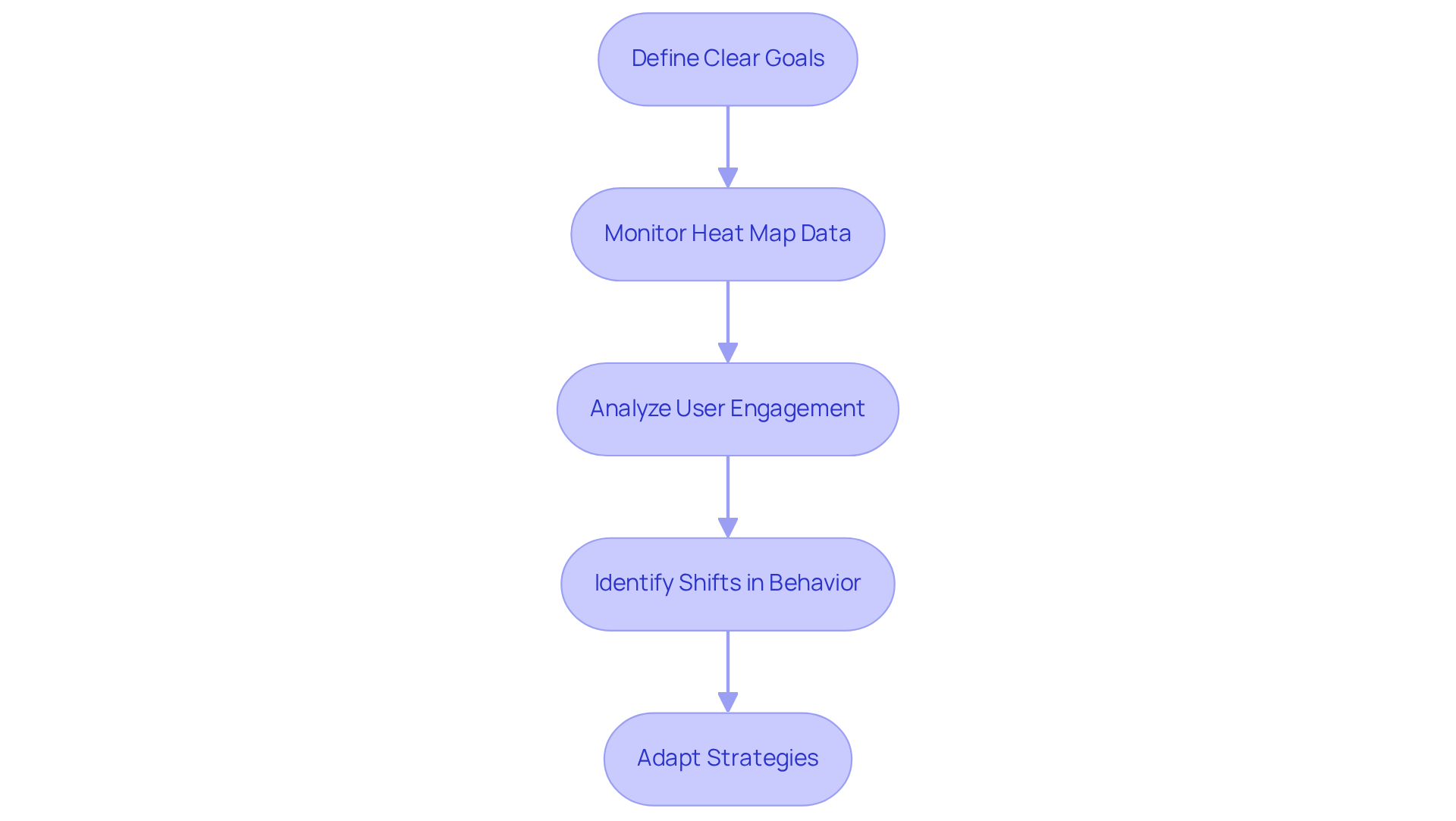
Prioritize Changes: Allocate Resources Effectively with Heat Map Insights
The heat map web insights empower companies to prioritize website modifications by pinpointing areas demanding immediate attention. By channeling resources toward high-impact sections, DTC companies can substantially elevate their ROI, ensuring that optimization efforts yield maximum results.
As Jack Welch aptly stated, 'Strategy is simply resource allocation. When you strip away all the noise, that’s what it comes down to.' This strategic allocation of resources is vital for cultivating profitability and sustainable growth.
Regular scrutiny of the heat map web data is essential for enhancing user experience, as it reveals user engagement trends and aids companies in refining their strategies to align with evolving consumer preferences.
Widely recognized tools like Hotjar and Crazy Egg are part of the heat map web that facilitates this process, ultimately resulting in enhanced performance.

Drive Profitability: Leverage Heat Maps for Sustainable Growth in DTC Brands
By effectively utilizing the heat map web, DTC companies can significantly enhance profitability through informed decision-making and strategic improvements. The insights gained from the heat map web analysis not only elevate user experience but also lead to substantial boosts in conversion rates, paving the way for sustainable growth. This focus on profitability aligns seamlessly with Parah Group's mission to aid companies in optimizing their resources and improving their bottom line.
For example, a $30M apparel company that partnered with Parah Group experienced a remarkable 35% increase in conversion rates and a 10% rise in revenue per visitor after implementing targeted strategies, including:
- Homepage redesigns
- Minimizing unnecessary pop-ups
- Gamifying progress bars for free shipping thresholds
Similarly, Grab Green, a $15M cleaning product company, achieved an impressive 80% increase in average order value (AOV) by optimizing their pricing, introducing bundles, and conducting price testing to identify the optimal price point.
Financial analysts emphasize that leveraging data-driven insights is crucial for companies aiming to thrive in a competitive landscape, where even a modest 5% increase in customer retention can translate to profit increases ranging from 25% to 95%. Furthermore, companies with active communities can witness a 10-20% rise in revenue per customer.
By concentrating on heat map web insights, DTC brands can discern user behavior patterns, refine their marketing strategies, and ultimately drive profitability. Incorporating methodologies such as A/B testing, customer segmentation, and predictive analytics further amplifies the effectiveness of these strategies, while ensuring that fast-loading websites and clear value propositions are prioritized to enhance conversion rates.
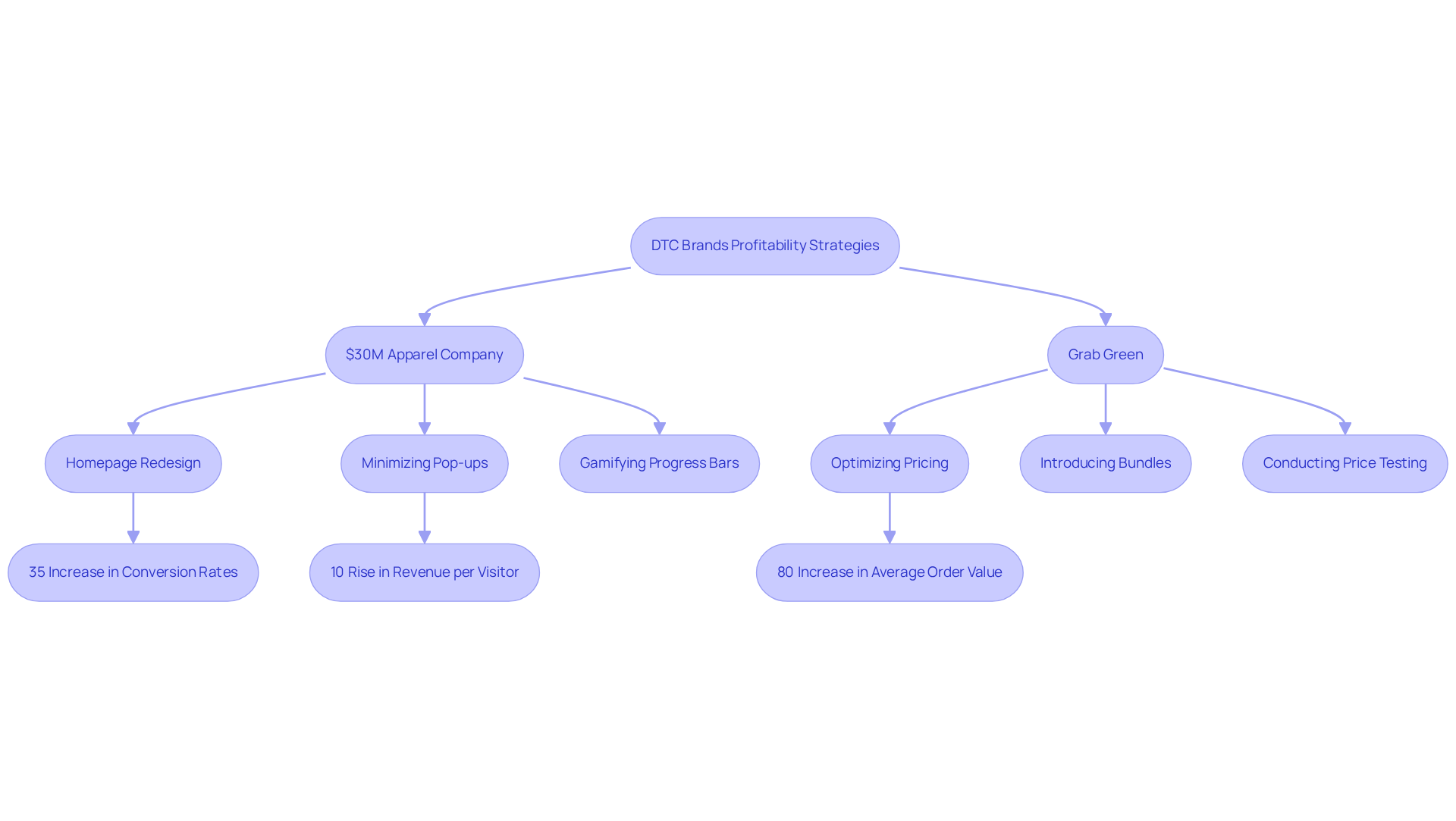
Conclusion
Utilizing heat map web insights is essential for direct-to-consumer (DTC) brands aiming to enhance their performance and profitability. By visualizing user interactions, these tools provide invaluable data that enables businesses to optimize their websites, ultimately leading to improved conversion rates and customer satisfaction. The insights gained from heat maps empower companies to make informed decisions that align with consumer behavior, ensuring a competitive edge in the digital marketplace.
Throughout this article, we have explored key strategies for leveraging heat maps, including:
- Enhancing conversion rates through targeted design changes
- Optimizing website layout to focus on high-traffic areas
- Improving user experience by identifying confusion points
Real-world case studies, such as those involving Parah Group and various successful DTC brands, highlight the tangible benefits of implementing heat map analysis. These examples demonstrate how data-driven adjustments can lead to significant increases in engagement and revenue.
In conclusion, embracing heat map web insights is not just a trend but a necessity for DTC brands striving for sustainable growth and profitability. By continuously monitoring user behavior and adapting strategies based on these insights, companies can foster stronger customer relationships and drive long-term success. As the retail landscape evolves, prioritizing data-driven decision-making through tools like heat maps will be pivotal in navigating the complexities of consumer engagement and achieving business objectives.
Frequently Asked Questions
What is heat map analysis and how does it benefit DTC companies?
Heat map analysis is a web analysis tool that visualizes user interactions on a website, showing where users click, scroll, and pause. This helps DTC companies gain actionable insights to boost conversion rates by optimizing their website for better engagement and profitability.
How has Parah Group utilized heat map analysis in their strategies?
Parah Group integrates heat map analysis into its Conversion Rate Optimization (CRO) strategy, aligning website elements with visitor expectations. This approach has led to significant increases in conversion rates for clients, such as a $30M clothing line that saw a 35% increase and Grab Green, which elevated its average order value by 80%.
What are the financial benefits of using heat map analysis?
Companies that employ heat map visuals enjoy an average return on investment of 223%, indicating their effectiveness in driving conversions and enhancing profitability.
How do heat maps help in understanding customer interactions?
Heat maps illustrate visitor behavior, revealing which sections of a website attract the most attention. This allows DTC companies to optimize content and layout, ensuring essential information is placed higher up on the page to enhance visibility and engagement.
What practical applications do heat maps have for improving website design?
Heat maps can identify crucial information that may be overlooked, allowing companies to adjust content positioning. This guides clients toward purchasing decisions, leading to a more seamless experience and higher conversion rates.
How can companies optimize their website layout using heat maps?
Companies can determine high-traffic areas on their website through heat map analysis, allowing them to strategically position key elements like calls to action and product displays in visible areas, which enhances audience engagement and conversion rates.
Can you provide an example of a company that improved its sales through heat map analysis?
Muc-Off experienced a 106% increase in purchases after redesigning their homepage based on insights from heat map analysis, demonstrating the impact of data-driven design changes.
What considerations should companies keep in mind when using heat map data?
Companies should consistently examine heat map visuals for ongoing improvement and ensure that the data is anonymized and compliant with regulations such as GDPR to address privacy concerns.
FAQs











